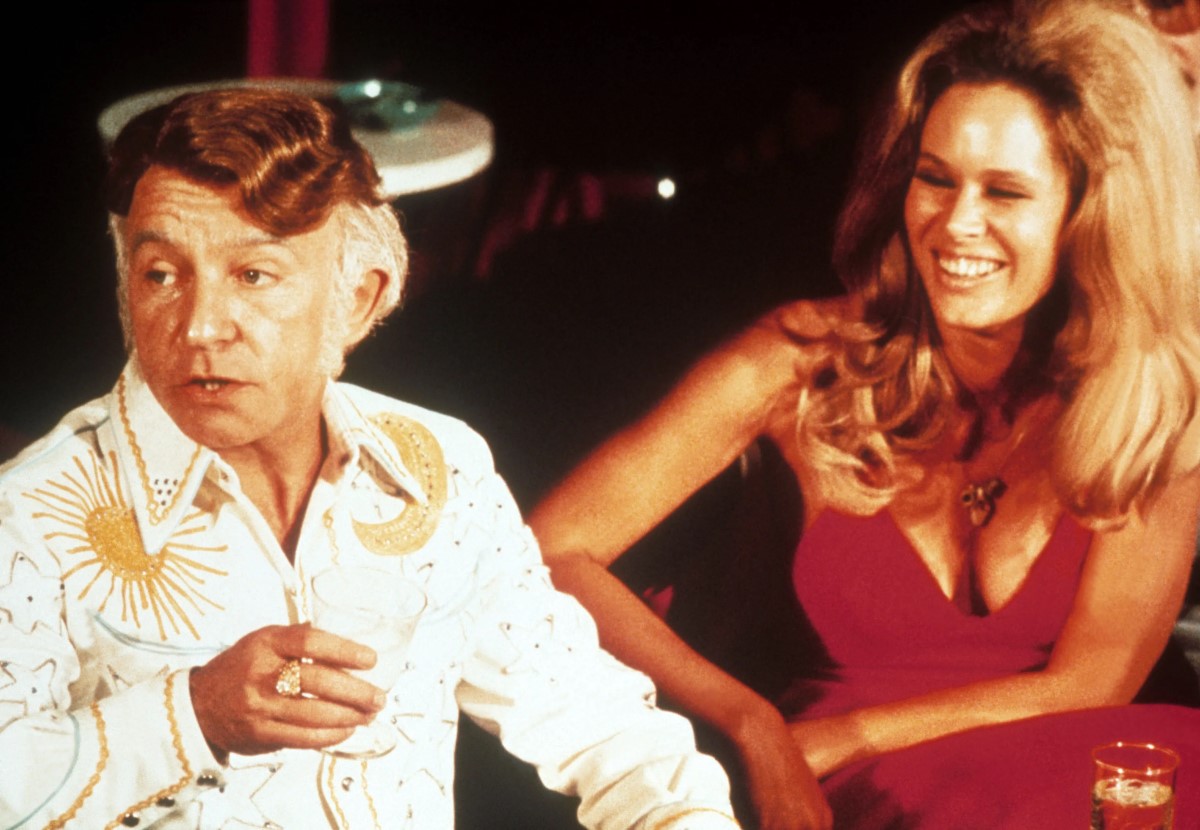by Pauline Kael
Early this year, the most successful of the large-circulation magazines for teen-age girls took a two-page spread in the Times for an “interview” with its editor-in-chief, and after the now ritual bulling (Question: “You work with young people—what is your view of today’s generation?” Answer: “My faith in them is enormous. They make a sincere attempt at being totally honest, at sharing. They’re happily frank about their experiences. They’re the most idealistic generation in history. . . . When you consider the vast problems confronting us, their optimism and activism is truly inspirational”), and after the obeisance to the new myths (“They are the best-educated and most aware generation in history”), the ad finally got to the come-on. Question: “Is it true that your readers don’t differentiate between your ads and your editorials?” Answer: “Yes, that’s true. Our readers are very impressionable, not yet cynical about advertising . . . eager to learn … to believe.” The frightening thing is, it probably is true that the teen-agers don’t differentiate between the ads and the editorials, and true in a much more complex sense than the delicately calculated Madison Avenue-ese of the editor’s pitch to advertisers indicates. Television is blurring the distinction for all of us; we don’t know what we’re reacting to anymore, and, beyond that, it’s becoming just about impossible to sort out the con from the truth because a successful con makes its lies come true.
A lot of the “film-generation” talk is, of course, business-inspired—an attempt to create a new youth market to replace the older audience lost to television—and, via the schools, the businessmen are making it true. The textbook The Motion Picture and the Teaching of English, financed by a grant from Teaching Film Custodians (an affiliate of the Motion Picture Association of America) to the National Council of Teachers of English, heralded the push into the schools, and teachers who want to be hip have taken up movies as what’s happening. Publishers have rushed to prepare books to take advantage of the new film courses, and conglomerates have bought up the 16-mm.-film-distribution companies in expectation of educational funds’ being poured into film rentals. Everywhere in the media, one has begun to hear of the wonderful new “visual literacy” possessed by the young—how, without effort, they have acquired a magical new kind of education from television. Teachers who couldn’t get their students to do any work and couldn’t think of anything else to do with them have begun to see the virtue of bombarding them with images, and so across the country the schools are acquiring the hardware of “visual literacy.” According to the pamphlet handed out at the 1970 New York Film Festival to encourage donations to the Film Society of Lincoln Center, “Once they were just ‘the movies.’ Now movies are the core language of the young. More than that . . . suddenly films have become the meaningful way for all generations, all nations, to really talk each other’s language.”
After a half century in which movies were indeed a medium that linked people, and gave us, for good and for ill, common experiences, we get this public-relations “suddenly” stuff when the bulk of American movies are being aimed directly at the young audience and are sold to it on the basis that it’s different from all previous audiences. In its small way, the pitch is as delicately calculated as the teen-age-magazine ad (the two are even dotted the same way). By the time the media men, with the teachers at their heels, have finished indoctrinating school kids to be the film generation, that “core language”—whatever it is—may be the only language they’ve got left. The joker in this stacked deck is that school kids and college students go to movies less frequently than earlier generations did. Although students are saturated from watching television at home (which may be a major factor in why they expect to be passively entertained at school and turn off when they aren’t), movies are being pushed in the school systems because the number of paid movie admissions per year is about a fourth of what it used to be. Movie companies are trying to develop new customers, like the tobacco companies when they sent free cartons to the soldiers in the Second World War, to get them hooked on cigarettes.
Actually, something has gone terribly wrong with movies. I think it can be said that the public no longer goes to them with much expectation of pleasure, and, as a result, many people have stopped going to any but the most highly praised and publicized films, and often regret going to those (such as Catch-22). Even college students, who do seem to make intense contact with a few films each year, don’t go to many new movies. Often they prefer old movies on television to the less publicized of the new films (they say they have a better time watching old movies), and they don’t go regularly to whatever is playing, as students used to. In fact, they, like the people in their thirties and forties, tend to go to the same few big hits—to Easy Rider and Midnight Cowboy and M*A*S*H— the difference being that they tend to go repeatedly. Most movies these days are made for nobody; the proportion of movies that fail commercially is at an all-time high, and now when they fail they often fail mercilessly—sometimes on the opening day of a first-run movie a theater does not sell a single ticket—so that investing money in movies is becoming a fantastic long-shot gamble against public apathy. Movie companies try to cut their losses by not releasing some of their less promising completed films; that way they save on advertising and the cost of making prints.
Laments for the entertaining movies of the past are pointless; with rare exceptions, those movies are still around to be seen and enjoyed at revivals or on television, but we cannot imitate them successfully now, nor should we try. Hollywood did try, and for far too long. The conventions of those movies were years ago drained of energy, and the movies that stick to them now, such as Airport, appeal to the sort of people who get their juices flowing by denouncing pictures like Candy and Myra Breckinridge and Beyond the Valley of the Dolls as morally subversive. We can’t, unless we’re stupid, ask film people to make movies the nice, stodgy way they (or their predecessors) used to. I can’t even review the $25 million dollar Tora! Tora! Tora! After a half hour, I fell into a comatose state; reprieved by the intermission, I sneaked away. It was always too late for a movie that thinks it’s being fair to the Japanese by having Japanese actors behave like slit-eyed Americans. The cast of non-Japanese—Leon Ames and Neville Brand and George Macready and James Whitmore and Wesley Addy and Leora Dana and E. G. Marshall, ad infinitum—has all the charisma of a veterans’ convention. With that weary bunch of second-string actors, the war seems to have been caused by American enervation, and with lines like “I must get back to the fleet. There is a lot to be done” who needs bombs? I do recall one joke, though an inadvertent one, when some poor historical facsimile of an actor stands by a window and cries, “For God’s sake, man, that’s not a paper fleet out there!”—and the view is so pathetically fake that one’s first thought is: Well, if it isn’t paper, what is it, an oil painting? This kind of moviemaking never carried any conviction; only in the heat of battle—and Vietnam isn’t that kind of battle—could audiences deceive themselves about its quality. Richard Fleischer’s direction has no bite, no tension, no beauty. One can’t get angry at the lack of depth, or at the pedantry about acts of treachery on one side and acts of incompetence on the other; this movie is too weakly uncertain of itself to be the occasion of anger. One merely dozes, knowing that Tora! Tora! Tora! is one of the last of its kind; the only question it raises is whether it will finally sink the oft-bombed Twentieth Century-Fox.
But, except for the big hits, the newer kinds of movies mostly don’t satisfy anybody. After the breakdown of the studio system, the good side of the chaotic situation got attention first, with the looser, more individual-in-style films of Sam Peckinpah, Mazursky and Tucker, Dennis Hopper, Robert Altman, and others; but the bad side is becoming overpowering, and that regular weekly audience, decimated by television, is being shriveled by too many nights at movies like End of the Road, The Looking-Glass War, Futz, Duffy, The Legend of Lylah Clare, The Bed Sitting Room, The Magus, Coming Apart, The Happy Ending, The Adventurers, The Magic Christian. Why should people submit to more? The answer is they don’t, and almost all the films released this summer have been box-office bummers. I don’t think it’s anything as simple as lack of talent; one does not have to be supremely talented to do entertaining work in films, and many of the men whose work has given enduring pleasure were probably less gifted than some of the men now making intolerably insensitive films. The problem may lie in the attitudes that permeate new films; even when they’re relatively clever and fast-moving, one is likely to come out depressed rather than refreshed, feeling disagreeable or angry from having so much unsorted-out material and gratuitous technique flung in one’s face. Is this perhaps because the moviemakers don’t have the respect for the audience essential to the creation of satisfying theatrical experiences?
Many of the men who have been quickest to take advantage of the flux since the conglomerate takeovers and failures are those with the low cunning to exploit the current mood of the young movie audience (as in Joe) or with the strong, shallow egos to convince the shaken-up studio heads that they know what the youth market will buy. The rising hacks now making deals have taken over some of the coarsest attitudes of the moguls and have left out one vital ingredient of old picturemaking. It used to be understood that no matter how low your estimate of the public intelligence was, how greedily you courted success, or how much you debased your material in order to popularize it, you nevertheless tried to give the audience something. That was the principal excuse for all the story conferences and the gimmicks and restrictions inflicted on the writers and directors by the producers, and even though this excuse was the basis for crippling men of talent and presenting garbage to the public, the excuse wasn’t totally false. It seems a little silly to have to point this out, but the assumption that a movie was supposed to do something for the audience was a sound one. The greatest moviemakers—men like Griffith and Renoir—were the men who not only wanted to give the audience of their best but had the most to give. This is also, perhaps, the element that, combined with originality of temperament, makes the greatest stars and enables them to last—what links a Louis Armstrong and an Olivier and a Streisand and maybe, with luck, a Flip Wilson. In the new, fluid movie situation, with some of the obstacles gone, it should be easier for artists to give everything they have; that’s what freedom means in the arts. Working at one’s peak capacity, going beyond one’s known self, giving everything one has, makes show business, from time to time, art.
Good hack work could be done under the old system, because even when you worked beneath your full capacity—grinding your teeth in frustration—you could still do an honest job, respectful of the audience’s needs, and some fine American movies were made as plain, honest jobs of hack work. But the American audience outgrew the conventional genre films. What new wine could be poured into the bottle of the western? (The new wine of The Wild Bunch explodes the bottle.) The myths of the Old West, with the heroic figures of authority and the coming of law and order, no longer touch off the right reverberations in an audience. The familiar patterns whose unfolding once gave the audience such anticipatory pleasure and such nostalgic satisfaction in the formal closing began instead to turn the surfeited audience derisive, and so the western heroes became camp figures who grew old and fat (as in True Grit) or Freudian-freaky (as in the Burt Kennedy westerns), or escaped to other countries (as in Butch Cassidy and the Sundance Kid). The strength had been sapped from the old genres; they belonged to the studio system, and the attempt by the nervous, unimaginative studio heads to cling to them sapped the studios.
But substituting the clichés of Madison Avenue militancy for the formulas and the middle-class banalities is a disaster at every level; in Europe a movie like The Strawberry Statement may be considered politically daring, but we here can recognize it for what it is—the twin of that teen-age-magazine pitch for the youth market. The puerile old romances may have been bourgeois, but at least they bound us together by reminding us of our common fantasies. Exploitation “message” movies like The Strawberry Statement, the brash, confident Getting Straight, and the new R.P.M. are more offensive. No contemporary American subject provided a better test of the new movie freedom than student unrest. It should have been a great subject: the students becoming idealists and trying to put their feelings about justice into practice; their impatience at delays; the relationship between boredom and activism; and what Angus Wilson has called “the mysterious bond that ties gentleness to brutality, a bond that has made our times at once so shocking and so hopeful.” Instead, we’ve been getting glib “statements” and cheap sex jokes, the zoomy shooting and shock cutting of TV commercials, plus a lot of screaming and ketchup on the lenses. These movies took the recently developed political consciousness of American students, which was still tentative and searching and (necessarily) confused, and reduced it to simplicities, overstatements, and lies. In the standard Hollywood vulgarizing tradition, the theme of student revolution was turned into a riot-movie fad, polished off now by Stanley Kramer’s grandstanding liberalism in his R.P.M. Though Anthony Quinn, as an acting college president, is the hero, and the movie is meant to show primarily the Kramer old-warrior-liberal side, the movie, for all its jabber of hating violence, nevertheless heads right toward it, just like Getting Straight and The Strawberry Statement. The directors present violence as the students’ only courageous course of action, not because it arises out of the given issues but because of their crudeness as moviegoers—because they want the smash finale of a big-production-number violent confrontation. They change their rhetoric but not their styles: Richard Rush’s carnage in Getting Straight is just like his carnage in the wheeler The Savage Seven; Stuart Hagmann is still making commercials in The Strawberry Statement.
In an article in the Times, Israel Horovitz explained that he didn’t write the screenplay of The Strawberry Statement for radicals. “We sit in New York,” he said, “and reek of sophistry.” From his ideas (“Isn’t it strange that man could invent wealth but never find a way to spread it around?”), he seems to be a sophistic Andy Hardy. He wrote the movie, he tells us, to radicalize a typical fifteen-year-old girl in his home town. His article could almost be a classic New Left parody of the old Hollywood explanations of why movies had to be made for twelve-year-old minds. How is it that, unlike the writers on the Andy Hardy pictures, who knew they were hacks when they wrote down to the audience, Mr. Horovitz does not know? How is it that Richard Rush and his scriptwriter, Robert Kaufman, do not know that when they reject criticism of Getting Straight (as they did in the Times) by appealing to the superior court of those “lined up every night in record numbers” they are giving the same old Hollywood answer, and that when they gild it with the information that these queues are composed of “the new generation of moviegoers who have taken film as their own medium, as their personal art form and instrument of communication” they are talking the Hollywoodspeak of Louis B. Mayer and Darryl F. Zanuck? Horovitz didn’t appeal to the court of the public, because The Strawberry Statement was a flop, but Rush and Kaufman had a hit, so they followed mogul tradition and claimed that the public knows best, or, as they put it, “There are other more demanding and uncompromising critics who will instantly reject a fraud. These critics are the new generation.”
The avowed aim of most of the new film men is to shatter the complacency of the audience. Michael Same, the director of Joanna and Myra Breckinridge, threatens us with more of the same until “some compromise is achieved between the generations and races, classes, and warring factions.” He and the others justify everything in their movies with slick revolutionary catch phrases; they are, they tell us, attacking the bestiality of our time by making brutal movies, attacking the shoddiness of American culture by shoving shoddiness down our throats. Their movies become our punishment, and the worse their movies turn out, the more self-righteously they explain that it was just what we deserved. They’re shaking up Middle America—us, the fifteen-year-olds in Israel Horovitz’ home town.
The weathercocks of movie business are the press releases. Here is one from 1969:
Stirling Silliphant will launch his first multiple-picture screenplay agreement by writing the film script for Harold Robbins’ forthcoming novel, The Inheritors, it was announced today by Joseph E. Levine, president of Avco Embassy Pictures. Silliphant will also write the scripts for
two more films for the company: All the Emperor’s Horses and America the Beautiful, and he will produce the latter. . . .
America the Beautiful is a satiric comedy about sex, security, and the “easy buck,’’ and is based on a series of essays published by David White.
The press reception at which the announcement was made was Silliphant’s first in New York since he left the helm of the Twentieth Century-Fox publicity department in 1953. “This time,” he quipped, “I’m on the other side of the fence.”
He isn’t; he’s still in the same business, whether he writes publicity or makes movies, whether he writes the script for The Inheritors or a script attacking men just like himself. Madison Avenue sells attacks on Madison Avenue the same way conglomerate-appointed studio heads grow beards and serve up the terrorist, utopian thinking that they hope will appeal to young ticket buyers.
While students don’t go to many movies (they read even less, and perhaps that’s why they’ve been named the film generation), the few movies each year that they do care about they seem to take more personally than earlier generations of students did. It’s the jackpot of turning out one of those few that the new moviemakers aim for. The movies that are popularly considered the best movies at any given time may or may not be good movies—they may be important bad movies—but they touch a nerve, express a mood that is just coming to popular consciousness, or present heroes who connect in new ways. They not only reflect what is going on in the country but, sometimes by expressing it and sometimes by distorting it, affect it, too—such movies as The Wild One, Rebel Without a Cause, Blackboard Jungle, On the Waterfront, Morgan!, Bonnie and Clyde, The Graduate, Midnight Cowboy, Easy Rider, the new Joe, and probably the new Five Easy Pieces. Movies like these enter the national bloodstream, and, at the moment, the few big movies seem to do so faster than ever before, and more directly—maybe because that “best-educated” generation in history is so nakedly vulnerable to whatever stirs it emotionally. This susceptibility, rather than “visual literacy,” is the distinctive trait of the “film generation”; the young go back to re-experience the movies they identify with, entering into them with a psychodrama involvement. Easy Rider tapped a vein of glamorous suicidal masochism, and Joe, a real mainliner, rushes in all the way. This picture is so slanted to feed the paranoia of youth that at its climax (a reversal of the Sharon Tate case), when the young hippies are massacred by the “straight” adults—the blue-collar bigot Joe and a liberal advertising man—members of the audience respond on cue with cries of “Next time we’ll have guns!” and “We’ll get you first, Joe!”
The apprehensiveness that one feels throughout Joe—the sense of violence perpetually about to erupt—makes it effective melodrama but also makes it an anxious, unpleasant experience. I had some doubts about the use of melodramatic techniques on the serious political theme of Z, but the director seemed reasonably responsible; in Joe the manipulation of the audience is so shrewdly, single-mindedly commercial that it’s rather terrifying to sit there and observe how susceptible the young audience is. Since the assassinations, there’s been a general feeling of powerlessness, and what gives Joe some of the validity that the audience reacts to is that the television and teen-age-magazine advertising-editorial lies have finally resulted in many young people’s not knowing how to sort things out, not caring, and not believing anything. They go numb, like the young girl in Joe looking vaguely for some communal Eden where those without hope can cling to each other, and they accept and prefer the loser self-image, not wanting to believe that anything good can happen to them. They don’t make it happen; they won’t even let it happen. Joe, written by another former advertising man, preys on this stoned hopelessness and martyrdom in a congratulatory way, and feeds the customers a series of tawdry cliches about the hypocrisy and hostility and rottenness of the straight world. Its message is that it’s all crap—the same message that gets shouts of approval and applause at Five Easy Pieces. The few new movies that the “film generation” responds to intensely are the most sentimental (about youth) and the most despairing (about America). It’s a bad combination.
The New Yorker March 10, 1970.
Reprinted in Deeper Into Movies, pp. 183-193





